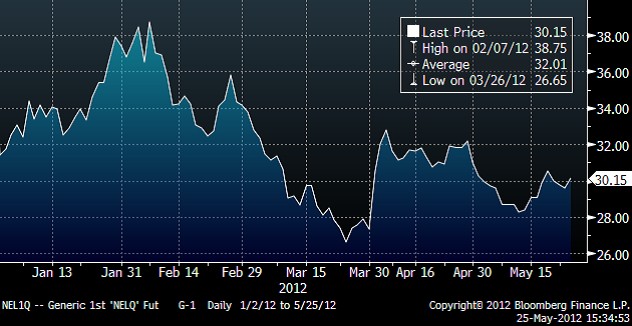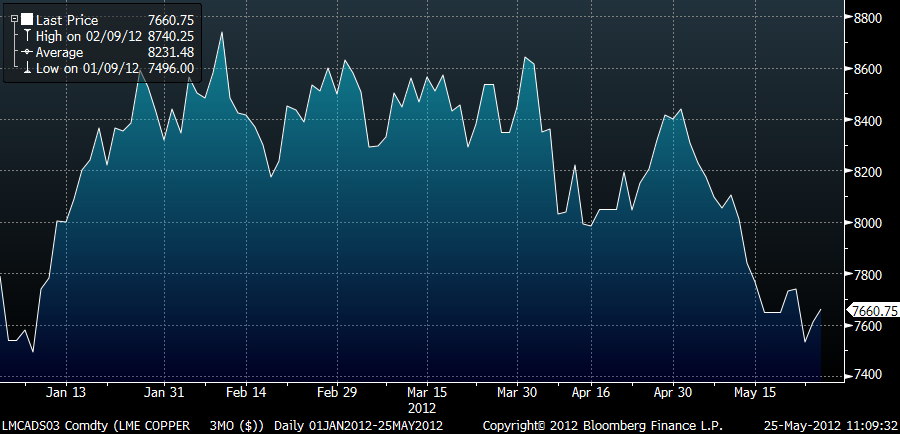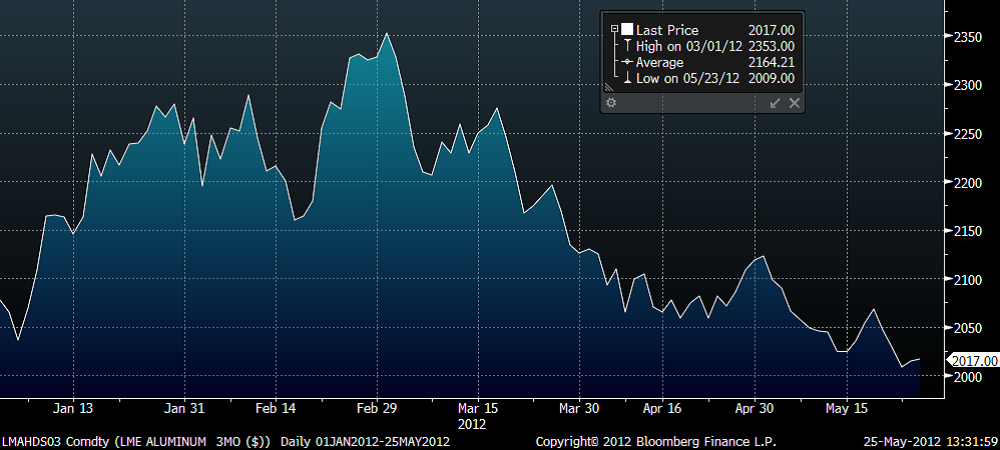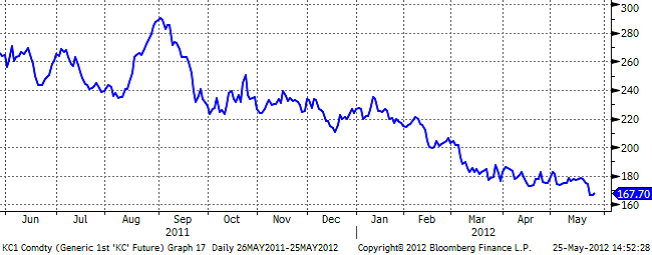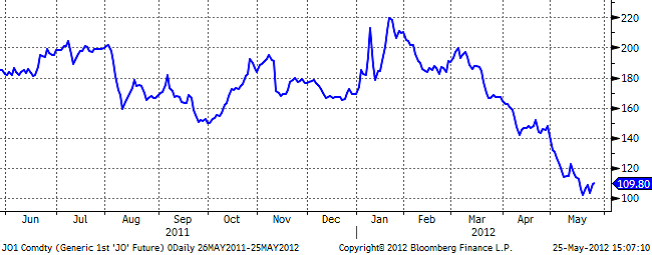Analys
SHB Råvarubrevet 25 maj 2012
 Marknaden har fortsatt att präglas av svalare riskaptit sedan förra veckobrevet. Råvaror tillsammans med börser och räntor har fallit. Oron för en grekisk närtida exit får sägas ha ökat, ratingnedgraderingarna har stått som spön i backen, spanska problemlån klättrar snabbt medan makrostatistiken inte gett några skäl till optimism. Kinadata har fortsatt att vara besvikelser med banken HSBCs preliminära inköpschefsindex för maj som senaste exempel. Vi tror på en kommande stark återhämtning för kinaexponerade råvaror – men inte ännu!
Marknaden har fortsatt att präglas av svalare riskaptit sedan förra veckobrevet. Råvaror tillsammans med börser och räntor har fallit. Oron för en grekisk närtida exit får sägas ha ökat, ratingnedgraderingarna har stått som spön i backen, spanska problemlån klättrar snabbt medan makrostatistiken inte gett några skäl till optimism. Kinadata har fortsatt att vara besvikelser med banken HSBCs preliminära inköpschefsindex för maj som senaste exempel. Vi tror på en kommande stark återhämtning för kinaexponerade råvaror – men inte ännu!
Parallellt med de negativa rubrikerna så har förväntansbilden skruvats ned kraftigt och det minskar risken för att makrodata blir besvikelser i närtid. När tillgångar har falligt med 10 – 15 % (OMX 30 och Brent) på mindre än två månader så brukar det komma en kort rekyl när köpintresset ökar igen.
Vi konstaterar att mycket dålig data kommit på kort tid och tryckt ner marknaden. Vi ser fortfarande flera nedåtrisker på 2 månaders sikt men tycker att detta kan vara ett intressant läge för den riskvillige att kortsiktigt söka avkastning i en annars dyster miljö. Vi favoriserar då mindre kinaexponerade råvaror som olja, som vi dessutom tycker har starkast fundamentalt stöd utav råvarorna.
Energi (neutral)
Olja
Oljemarknaden (Brent) som backade med ytterligare 3 procent ned till 105 dollar under inledningen av veckan återhämtar delar av rörelsen mot slutet vilket får ses som en korrektion. Fokus på Europa och lägre riskaptit för råvaror överlag men ser vi till det fundamentala lär även förbrukningsprognoser för den amerikanska marknaden skrivas ned något ytterligare inom den närmaste framtiden. En del stöd från amerikanska bensinlager som fortsatte ned och totalt nu fallit med 30 miljoner fat de senaste tre månaderna. Inga stora nyheter kring Iran där diskussionerna kring kärnvapenprogrammet flyttas fram till nästa månad. En nyhet om 300,000 fat mindre Iransk olja till marknaden med ett potentiellt scenario om 1 miljoner bortfall skulle tidigare givit ett ordentligt stöd åt köparna men i denna pessimistiska miljö påverkar det knappt alls. Trots en tekniskt väldigt översåld marknad verkar det fortsatt som risken finns på nedsidan på kort sikt.
Elmarknaden
Den försvagade energibalansen som bidrog till förra veckans uppgång genererade även inledningsvis av denna vecka en del köpintressen i marknaden. Överskottet om närmare 12 TWh har krympt till 6TWh på lite drygt en månad. Kvartalet Q3 2012 som är underliggande för SHB Power Index och våra sparprodukter handlas dock oförändrat efter att sentimentet försvagades något i mitten av veckan till följd av den allmänna utvecklingen på börserna. Mot slutet av veckan pekar prognoserna fortsatt på ett något torrare scenario där vi förväntas få mellan 2-4 TWh vilket därmed är något under normalen om 4.2 TWh för perioden. Denna högtrycksuppbyggnad och torra period har balanserats något av den svaga kolmarknaden där ett stort överskott och en stark dollar verkat negativt för kol och dämpa utvecklingen på el. En viss rekyl på både kol (där brytpriset för kolkraft stigit med ca 1 euro) och utsläppsrätter mot slutet av veckan men vi bedömer detta som tillfälligt och förväntar oss ingen vidare uppgång, snarare tvärtom.
Ser vi till den korta kurvan så är spotpriserna riktigt låga och väntas så vara även under nästa vecka. De höga temperaturerna gör att vattenproducenter har svårt att upprätthålla spotpriset på någon högre nivå till följd av den kraftiga snösmältningen. För att sammanfatta läget talar flera faktorer för att vi kommer att ligga kvar på dessa låga nivåer och om inte prognoserna slår om till betydligt torrare än de vi ser idag bör Q3 2012 kunna falla tillbaka någon euro under inledningen av nästa vecka.
Basmetaller (neutral)
Kopparpriset har pendlat upp och ner i pris under veckan för att stänga på ungefär oförändrat. Sedan årets början är priset ned ca 1.7 %. Koppar har den senaste tiden tagit stryk på grund av oron kring Grekland och världsekonomin. Som bekant anses metallen vara en ledande indikator för världskonjunkturen.
Kopparlagren från LME ökade för första gången på 7 veckor. Nyligen släppta produktionssiffror visar på att brytningen av koppar kommer överstiga efterfrågan redan i år och även 2014. I den andra vågskålen hittar vi siffror från världens största kopparproducent, chilenska Codelco. Företaget har producerat 10 % mindre koppar första kvartalet jämfört med första kvartalet 2011. Den främsta anledningen sägs vara minskade kopparhalter i malmen. Sammantaget är vi neutrala till kopparpriset.
Aluminiumpriset har under veckan gått ned med 2.4 %. Nedgången hittills i år är 2.8 %. Priset ligger i skrivande stund på 2 018 USD/ton. Ett flertal kunder har visst intresse att köpa strax över 2 000 USD-nivån. Cash-cost, det vill säga kostnaden för att få fram ett ton, ligger runt 1 900 enligt flera bedömare. Att kunna säkra in sin exponering på något över 2 000 har lockat in köparna.
Om vi försöker hitta positiva signaler kring världsekonomin så hittar vi det faktiskt i aluminiummarknaden. Leveranser till japanska förbrukare är upp för den tredje månaden i rad. Vi även snappat upp att importen av bauxit (råvaran till aluminium) till Kina har gått 49 % jämfört med förra året. Vi är neutrala till metaller och aluminium prismässigt, men tror att aluminium har bäst potential för prisuppgång på sikt.
Ädelmetaller
I slutet av förra veckan studsade guldet upp ganska ordentligt från nya årslägsta-nivåer, men denna veckan har vi sett det glida tillbaks med 2 %. Även övriga ädelmetaller har fallit i samma storleksordning, under en lugn vecka. Vi håller fast vår negativa syn på sektorn baserat på avsaknad av performance i den riskaverta miljö vi haft under senare tid.
Softs
Kaffe
Marknaden inväntar de brasilianska arabica skördarna vilka fortskrider något långsammare i år än tidigare år p.g.a. regn. Skördarna förväntas bli goda till följd av gynnsamma väderförhållanden under gångna säsongen men det råder fortsättningsvis en ovisshet beträffande landets kommande exportvolym då man ser en ökad inhemsk konsumtion. Efterfrågan på arabica kaffet har varit låg då flertalet köpare haft välfyllda lager inför skörden 2012/13.
Priset på arabica bönan har sjunkit drygt 20 % under 2012 inväntandes 2011/12 skörden vi nu står inför, kaffekonsumtionen förväntas öka globalt de kommande åren och skörden 2013-14 benämns som ett ”off” år i arabicakaffets skördecykler (högre/lägre skörd vartannat år).
Socker
Socker handlades upp något i början av veckan till följd av det något torrare vädret i Brasilien och därmed risk för sämre skördar. Även en något ökad efterfrågan och rapporter om ökat antal lastfartyg vid de brasilianska hamnarna redo för lastning av råvaran fick priset att stiga. Det ekonomiska läget i Europa fick priset på socker att sjunka igen mot mitten av veckan och handlas fortsättningsvis lågt. Marknaden är något avvaktande inför brasilianska skördeperioden som inleds om bara några veckor, och inväntar även handeln inför ramadan som hittills varit modest. Ramadan inleds i juli och de muslimska länderna brukar fylla sina lager innan dess. Indien som förra veckan beslöt att tillåta obegränsad export av socker har inte publicerat sin planerade exportvolym. Indiens skördar är goda i år och det socker de inte exporterar i år har de möjlighet att lagra för export nästa år, vilket i sin tur kan påverka priset på sikt.
Apelsinjuice
Priset på apelsinjuice fortsätter på sin låga nivå till följd av ökat utbud och den rådande ekonomiska situationen i Europa håller efterfrågan på fortsatt låga nivåer. Väderförhållandena har varit gynnsamma och skördarna är goda. Florida närmar sig orkansäsongen och antalet namngivna orkaner motsvarar tidigare år även om man i år inväntar orkaner något tidigare på säsongen. Även om säsongens tidiga orkaner i sig inte verkar utgöra något större hot för skörden påminner de marknaden om risken och tillfälliga uppgångar i priset har setts. Brasiliens Real har tappat 5,5 % mot USD sedan jan 2012.
Handelsbankens Råvaruindex
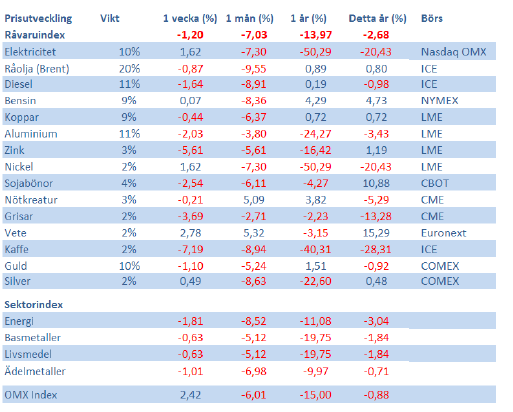 Handelsbankens råvaruindex består av de underliggande indexen för respektive råvara. Vikterna är bestämda till hälften från värdet av global produktion och till hälften från likviditeten i terminskontrakten.
Handelsbankens råvaruindex består av de underliggande indexen för respektive råvara. Vikterna är bestämda till hälften från värdet av global produktion och till hälften från likviditeten i terminskontrakten.
[box]SHB Råvarubrevet är producerat av Handelsbanken och publiceras i samarbete och med tillstånd på Råvarumarknaden.se[/box]
Ansvarsbegränsning
Detta material är producerat av Svenska Handelsbanken AB (publ) i fortsättningen kallad Handelsbanken. De som arbetar med innehållet är inte analytiker och materialet är inte oberoende investeringsanalys. Innehållet är uteslutande avsett för kunder i Sverige. Syftet är att ge en allmän information till Handelsbankens kunder och utgör inte ett personligt investeringsråd eller en personlig rekommendation. Informationen ska inte ensamt utgöra underlag för investeringsbeslut. Kunder bör inhämta råd från sina rådgivare och basera sina investeringsbeslut utifrån egen erfarenhet.
Informationen i materialet kan ändras och också avvika från de åsikter som uttrycks i oberoende investeringsanalyser från Handelsbanken. Informationen grundar sig på allmänt tillgänglig information och är hämtad från källor som bedöms som tillförlitliga, men riktigheten kan inte garanteras och informationen kan vara ofullständig eller nedkortad. Ingen del av förslaget får reproduceras eller distribueras till någon annan person utan att Handelsbanken dessförinnan lämnat sitt skriftliga medgivande. Handelsbanken ansvarar inte för att materialet används på ett sätt som strider mot förbudet mot vidarebefordran eller offentliggörs i strid med bankens regler.
Analys
More weakness and lower price levels ahead, but the world won’t drown in oil in 2026

Some rebound but not much. Brent crude rebounded 1.5% yesterday to $65.47/b. This morning it is inching 0.2% up to $65.6/b. The lowest close last week was on Thursday at $64.11/b.

The curve structure is almost as week as it was before the weekend. The rebound we now have gotten post the message from OPEC+ over the weekend is to a large degree a rebound along the curve rather than much strengthening at the front-end of the curve. That part of the curve structure is almost as weak as it was last Thursday.
We are still on a weakening path. The message from OPEC+ over the weekend was we are still on a weakening path with rising supply from the group. It is just not as rapidly weakening as was feared ahead of the weekend when a quota hike of 500 kb/d/mth for November was discussed.
The Brent curve is on its way to full contango with Brent dipping into the $50ies/b. Thus the ongoing weakening we have had in the crude curve since the start of the year, and especially since early June, will continue until the Brent crude oil forward curve is in full contango along with visibly rising US and OECD oil inventories. The front-month Brent contract will then flip down towards the $60/b-line and below into the $50ies/b.
At what point will OPEC+ turn to cuts? The big question then becomes: When will OPEC+ turn around to make some cuts? At what (price) point will they choose to stabilize the market? Because for sure they will. Higher oil inventories, some more shedding of drilling rigs in US shale and Brent into the 50ies somewhere is probably where the group will step in.
There is nothing we have seen from the group so far which indicates that they will close their eyes, let the world drown in oil and the oil price crash to $40/b or below.
The message from OPEC+ is also about balance and stability. The world won’t drown in oil in 2026. The message from the group as far as we manage to interpret it is twofold: 1) Taking back market share which requires a lower price for non-OPEC+ to back off a bit, and 2) Oil market stability and balance. It is not just about 1. Thus fretting about how we are all going to drown in oil in 2026 is totally off the mark by just focusing on point 1.
When to buy cal 2026? Before Christmas when Brent hits $55/b and before OPEC+ holds its last meeting of the year which is likely to be in early December.
Brent crude oil prices have rebounded a bit along the forward curve. Not much strengthening in the structure of the curve. The front-end backwardation is not much stronger today than on its weakest level so far this year which was on Thursday last week.

The front-end backwardation fell to its weakest level so far this year on Thursday last week. A slight pickup yesterday and today, but still very close to the weakest year to date. More oil from OPEC+ in the coming months and softer demand and rising inventories. We are heading for yet softer levels.

Analys
A sharp weakening at the core of the oil market: The Dubai curve

Down to the lowest since early May. Brent crude has fallen sharply the latest four days. It closed at USD 64.11/b yesterday which is the lowest since early May. It is staging a 1.3% rebound this morning along with gains in both equities and industrial metals with an added touch of support from a softer USD on top.

What stands out the most to us this week is the collapse in the Dubai one to three months time-spread.
Dubai is medium sour crude. OPEC+ is in general medium sour crude production. Asian refineries are predominantly designed to process medium sour crude. So Dubai is the real measure of the balance between OPEC+ holding back or not versus Asian oil demand for consumption and stock building.
A sharp weakening of the front-end of the Dubai curve. The front-end of the Dubai crude curve has been holding out very solidly throughout this summer while the front-end of the Brent and WTI curves have been steadily softening. But the strength in the Dubai curve in our view was carrying the crude oil market in general. A source of strength in the crude oil market. The core of the strength.
The now finally sharp decline of the front-end of the Dubai crude curve is thus a strong shift. Weakness in the Dubai crude marker is weakness in the core of the oil market. The core which has helped to hold the oil market elevated.
Facts supports the weakening. Add in facts of Iraq lifting production from Kurdistan through Turkey. Saudi Arabia lifting production to 10 mb/d in September (normal production level) and lifting exports as well as domestic demand for oil for power for air con is fading along with summer heat. Add also in counter seasonal rise in US crude and product stocks last week. US oil stocks usually decline by 1.3 mb/week this time of year. Last week they instead rose 6.4 mb/week (+7.2 mb if including SPR). Total US commercial oil stocks are now only 2.1 mb below the 2015-19 seasonal average. US oil stocks normally decline from now to Christmas. If they instead continue to rise, then it will be strongly counter seasonal rise and will create a very strong bearish pressure on oil prices.
Will OPEC+ lift its voluntary quotas by zero, 137 kb/d, 500 kb/d or 1.5 mb/d? On Sunday of course OPEC+ will decide on how much to unwind of the remaining 1.5 mb/d of voluntary quotas for November. Will it be 137 kb/d yet again as for October? Will it be 500 kb/d as was talked about earlier this week? Or will it be a full unwind in one go of 1.5 mb/d? We think most likely now it will be at least 500 kb/d and possibly a full unwind. We discussed this in a not earlier this week: ”500 kb/d of voluntary quotas in October. But a full unwind of 1.5 mb/d”
The strength in the front-end of the Dubai curve held out through summer while Brent and WTI curve structures weakened steadily. That core strength helped to keep flat crude oil prices elevated close to the 70-line. Now also the Dubai curve has given in.
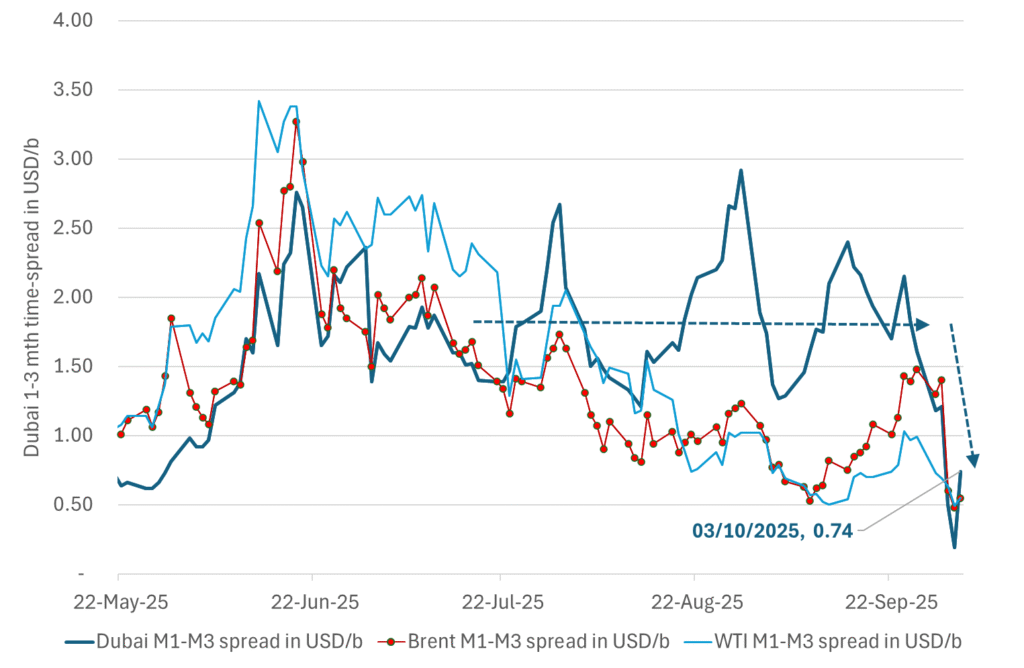
Brent crude oil forward curves

Total US commercial stocks now close to normal. Counter seasonal rise last week. Rest of year?
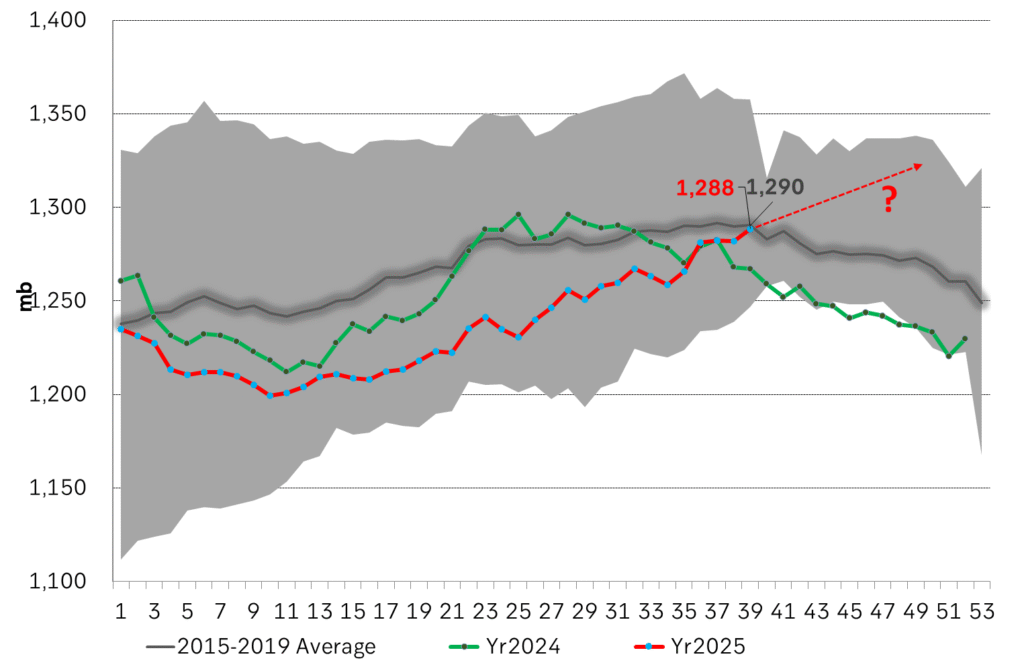
Total US crude and product stocks on a steady trend higher.
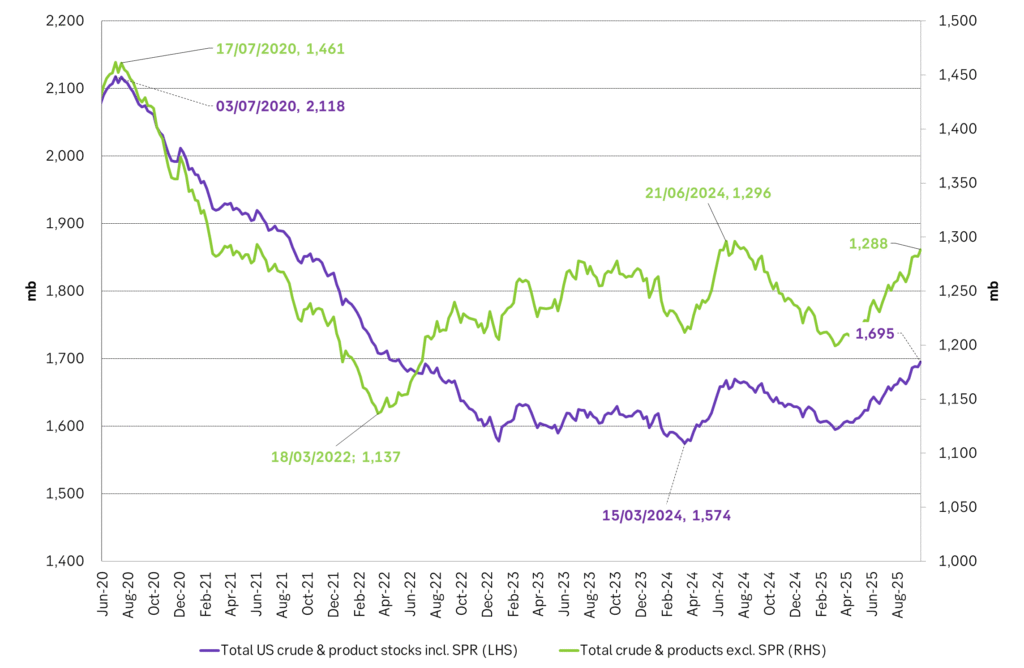
Analys
OPEC+ will likely unwind 500 kb/d of voluntary quotas in October. But a full unwind of 1.5 mb/d in one go could be in the cards

Down to mid-60ies as Iraq lifts production while Saudi may be tired of voluntary cut frugality. The Brent December contract dropped 1.6% yesterday to USD 66.03/b. This morning it is down another 0.3% to USD 65.8/b. The drop in the price came on the back of the combined news that Iraq has resumed 190 kb/d of production in Kurdistan with exports through Turkey while OPEC+ delegates send signals that the group will unwind the remaining 1.65 mb/d (less the 137 kb/d in October) of voluntary cuts at a pace of 500 kb/d per month pace.

Signals of accelerated unwind and Iraqi increase may be connected. Russia, Kazakhstan and Iraq were main offenders versus the voluntary quotas they had agreed to follow. Russia had a production ’debt’ (cumulative overproduction versus quota) of close to 90 mb in March this year while Kazakhstan had a ’debt’ of about 60 mb and the same for Iraq. This apparently made Saudi Arabia angry this spring. Why should Saudi Arabia hold back if the other voluntary cutters were just freeriding? Thus the sudden rapid unwinding of voluntary cuts. That is at least one angle of explanations for the accelerated unwinding.
If the offenders with production debts then refrained from lifting production as the voluntary cuts were rapidly unwinded, then they could ’pay back’ their ’debts’ as they would under-produce versus the new and steadily higher quotas.
Forget about Kazakhstan. Its production was just too far above the quotas with no hope that the country would hold back production due to cross-ownership of oil assets by international oil companies. But Russia and Iraq should be able to do it.
Iraqi cumulative overproduction versus quotas could reach 85-90 mb in October. Iraq has however steadily continued to overproduce by 3-5 mb per month. In July its new and gradually higher quota came close to equal with a cumulative overproduction of only 0.6 mb that month. In August again however its production had an overshoot of 100 kb/d or 3.1 mb for the month. Its cumulative production debt had then risen to close to 80 mb. We don’t know for September yet. But looking at October we now know that its production will likely average close to 4.5 mb/d due to the revival of 190 kb/d of production in Kurdistan. Its quota however will only be 4.24 mb/d. Its overproduction in October will thus likely be around 250 kb/d above its quota with its production debt rising another 7-8 mb to a total of close to 90 mb.
Again, why should Saudi Arabia be frugal while Iraq is freeriding. Better to get rid of the voluntary quotas as quickly as possible and then start all over with clean sheets.
Unwinding the remaining 1.513 mb/d in one go in October? If OPEC+ unwinds the remaining 1.513 mb/d of voluntary cuts in one big go in October, then Iraq’s quota will be around 4.4 mb/d for October versus its likely production of close to 4.5 mb/d for the coming month..
OPEC+ should thus unwind the remaining 1.513 mb/d (1.65 – 0.137 mb/d) in one go for October in order for the quota of Iraq to be able to keep track with Iraq’s actual production increase.
October 5 will show how it plays out. But a quota unwind of at least 500 kb/d for Oct seems likely. An overall increase of at least 500 kb/d in the voluntary quota for October looks likely. But it could be the whole 1.513 mb/d in one go. If the increase in the quota is ’only’ 500 kb/d then Iraqi cumulative production will still rise by 5.7 mb to a total of 85 mb in October.
Iraqi production debt versus quotas will likely rise by 5.7 mb in October if OPEC+ only lifts the overall quota by 500 kb/d in October. Here assuming historical production debt did not rise in September. That Iraq lifts its production by 190 kb/d in October to 4.47 mb/d (August level + 190 kb/d) and that OPEC+ unwinds 500 kb/d of the remining quotas in October when they decide on this on 5 October.
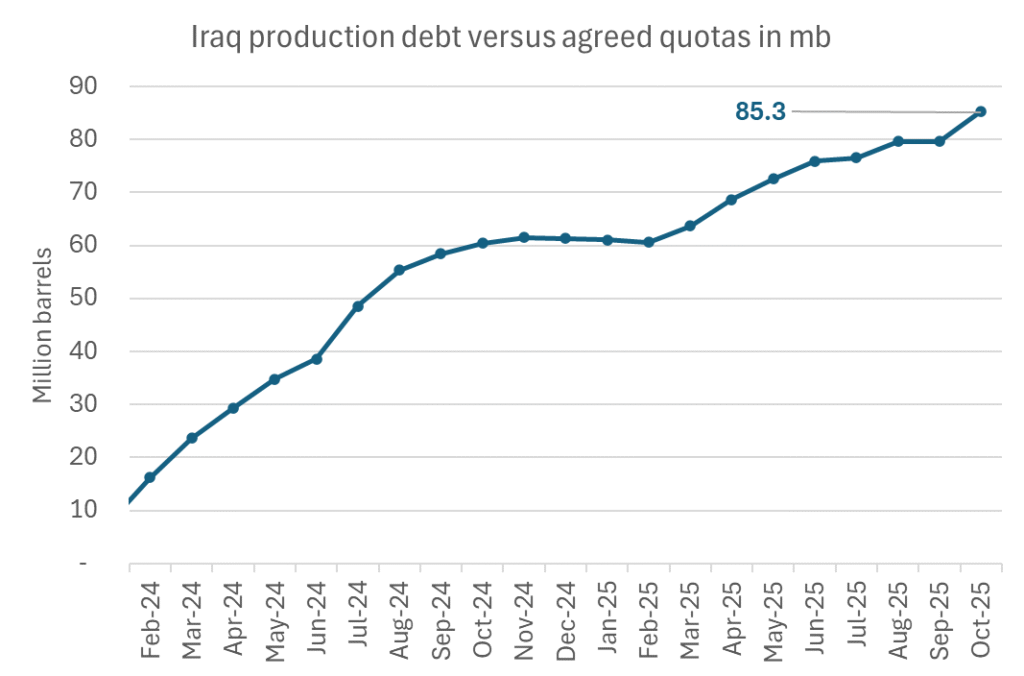
-

 Nyheter4 veckor sedan
Nyheter4 veckor sedanMahvie Minerals i en guldtrend
-

 Analys4 veckor sedan
Analys4 veckor sedanVolatile but going nowhere. Brent crude circles USD 66 as market weighs surplus vs risk
-
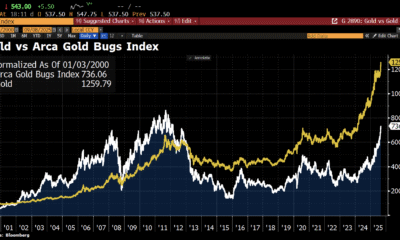
 Nyheter4 veckor sedan
Nyheter4 veckor sedanAktier i guldbolag laggar priset på guld
-

 Nyheter4 veckor sedan
Nyheter4 veckor sedanKinas elproduktion slog nytt rekord i augusti, vilket även kolkraft gjorde
-

 Nyheter4 veckor sedan
Nyheter4 veckor sedanTyskland har så höga elpriser att företag inte har råd att använda elektricitet
-
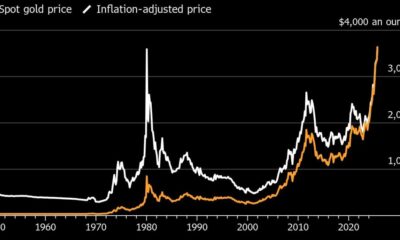
 Nyheter4 veckor sedan
Nyheter4 veckor sedanGuld når sin högsta nivå någonsin, nu även justerat för inflation
-
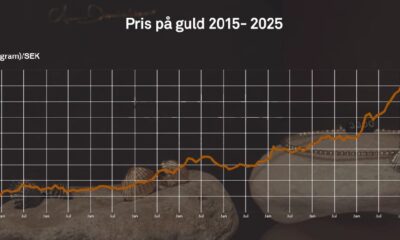
 Nyheter4 veckor sedan
Nyheter4 veckor sedanDet stigande guldpriset en utmaning för smyckesköpare
-

 Analys4 veckor sedan
Analys4 veckor sedanBrent crude ticks higher on tension, but market structure stays soft


